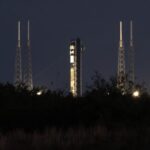Stars die and vanish from sight all the time, but astronomers were puzzled when one that had been stable for more than a decade almost disappeared for eight months.
phys.org27- Page
Asteroid Bennu—the target of NASA’s OSIRIS-REx sample return mission, led by the University of Arizona—is a mixture of materials from throughout, and even beyond, our solar system. Over the past
On Mars, the past is written in stone—but the present is written in sand. Last week, Perseverance explored inactive megaripples to learn more about the wind-driven processes that are reshaping
Researchers hope to use neutrinos to find the sources of cosmic radiation. New algorithms out of Bochum are aiding in the search, and have also eliminated a few candidates.
As missions like Kepler and TESS discovered more rocky exoplanets in recent years, scientists looked forward to the launch of the JWST. The powerful space telescope has the ability to
The universe captured by Hyper Suprime-Cam (HSC), the ultra-wide field of view camera, is truly magnificent. In this image, two spiral galaxies in the lower right immediately catch the eye:
Another U.S. military mini shuttle blasted off Thursday night to conduct classified experiments in space.
More than 5,000 planets have been discovered beyond our solar system, allowing scientists to explore planetary evolution and consider the possibility of extraterrestrial life. Now, a UC Riverside study published
NASA’s Artemis II mission, set to send four astronauts on a nearly 10-day mission around the moon and back, will advance the agency’s goal to land astronauts at the moon’s
Researchers at Durham and collaborators in the Dark Energy Spectroscopic Instrument (DESI) mission have proposed a bold new theory that black holes could be converting matter into dark energy.
-
 012024 in Review: Highlights from NASA in Silicon Valley
012024 in Review: Highlights from NASA in Silicon Valley -
 02Panasonic Leica Summilux DG 15mm f/1.7 ASPH review
02Panasonic Leica Summilux DG 15mm f/1.7 ASPH review -
 03How New NASA, India Earth Satellite NISAR Will See Earth
03How New NASA, India Earth Satellite NISAR Will See Earth -
 04And Thus Begins A New Year For Life On Earth
04And Thus Begins A New Year For Life On Earth -
 05Astronomy Activation Ambassadors: A New Era
05Astronomy Activation Ambassadors: A New Era -
06SpaceX launch surge helps set new global launch record in 2024
-
 07Space Force plans new ‘Futures Command’ amid pressure to speed up modernization
07Space Force plans new ‘Futures Command’ amid pressure to speed up modernization





